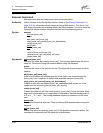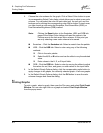
B – Graphing Port Performance
Starting SANsurfer Fabric View
B-2 59022-08 Rev. B
D
Save and Open SANsurfer Fabric View Default Fabric View Files
Change the SANsurfer Fabric View Default Fabric File Password
Set SANsurfer Fabric View preferences
Set the polling frequency
Display graphs
Print graphs
Rescale a selected graph
Save graph statistics to a file
B.1
Starting SANsurfer Fabric View
To start SANsurfer Fabric View from within SANbox Manager, open the topology
display and select Start Fabric View from the Fabric menu. When starting the
SANsurfer Fabric View application from the SANbox Manager application on
Linux and Solaris platforms, the fabric currently displayed in the SANbox Manager
topology display opens automatically in the SANsurfer Fabric View topology
display. On the Windows platform, you will need to manually open the fabric in the
SANsurfer Fabric View topology display.
B.2
Exiting SANsurfer Fabric View
To exit a SANsurfer Fabric View session, open the File menu and select Exit. The
current fabric view is automatically saved to your default fabric view file upon exit,
if you have defined an encryption key. The key is encrypted and saved with your
default fabric view file. A fabric view file contains the set of fabrics that have been
added and the graphs that have been opened during a SANsurfer Fabric View
session. If you have not yet defined an encryption key, the Save Default Fabric
View File dialog, shown in Figure B-2, prompts you to save the current fabric view
as the default fabric view file. Refer to ”Changing the Default Fabric View File
Encryption Key” on page B-4 for information about defining and changing this
encryption key.
Note: On the Solaris platform, if you launch the SANsurfer Fabric View
application from the SANbox Manager application and SANsurfer
Fabric View can not connect to the fabric, (for example, if you have
reached the maximum number of SANbox Manager sessions on the
entry switch), then SANsurfer Fabric View opens with a blue fabric icon
displayed in the fabric tree. The reason for status displayed after the
fabric name in the fabric tree will indicate the reason for failure to
connect.


















